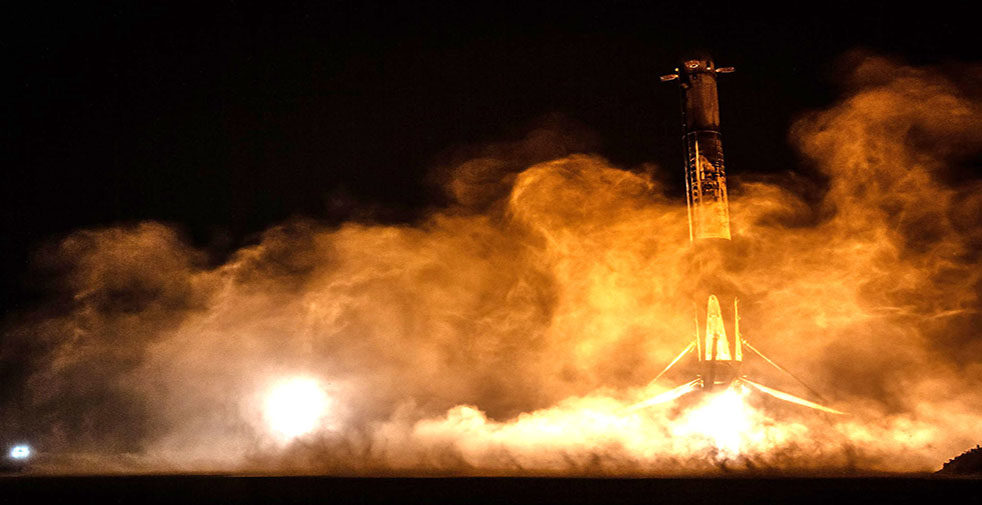50 minutes to liftoff, the SpaceX Launch Director verifies go for loading propellant.
A crowd of hundreds waited in anticipation on rows of metal bleachers in a scene where the excitement of the Super Bowl was fit into a high school baseball stadium. SpaceX’s Falcon Heavy, the world’s most powerful operational rocket, is only four miles away. Even from that distance, the 23-story tall spacecraft has a towering presence over the view. And as liquid oxygen and rocket grade kerosene fill up the rocket’s stages, the crowd’s anticipation grows.
7 minutes left, and the crowd at Banana Creek can see the smoke from the pre-launch engine chill coming off of the rocket.
All conditions seemed perfect for the private aerospace company’s most complex mission to date, much to the relief of everyone that worked on the nearly two dozen satellites in the rocket’s payload. What made this mission so difficult was the fact that different satellites required different orbits and different times to be released. But all that was left now was to wait.
At 60 seconds, the lights illuminating the viewing area shut off, leaving only the launchpad, a moon half-full and stars waking up from their daytime slumber visible in the night sky.
All eyes, cameras and phones were pointed at the rocket, especially those belonging to six Tech aerospace engineers both past and present. Prox-1, a 154-pound multi-year student satellite project, was the culmination of each of their efforts. Each of the students in attendance worked on the satellite at different times, but all were unified by the same sense of accomplishment.
Kyle Scott, an Integration and Technical Lead, sat in excitement for his first launch ever. “I never imagined I would build a satellite before I came [to Tech], and that feeling of shock and awe hasn’t totally left.”
At 45 seconds, The SpaceX Launch Director verifies a go for launch, and the crowd hears in approval.
Two years after shipping off their satellite to the Air Force for verification, any remaining doubt disappeared. Once it was finally in space, Prox-1’s mission was twofold: managing five spacecraft already in space and deploying a solar-powered sailing satellite named “LightSail.” The latter was developed by the Planetary Society, an independent space group headed by the one and only Bill Nye. 10 years in the making, LightSail would unfurl a massive sail and attempt to become the first spacecraft to be powered solely by solar power.
“The thrill of seeing our work launched into space never gets old,” said Professor E. Glenn Lightsey, one of the instructors who oversaw the project. “It’s not just the sense of accomplishment, but also the sense of pride and closure in a job well-done.”
Other satellites came from the Defense Department, NASA, the National Oceanic and Atmospheric association and a number of other private companies.
One of the NASA payloads was a small satellite of test rocket fuel designed to be more environmentally friendly. Current spacecraft use a propellant called hydrazine, which is toxic enough that perople near it must wear protective Hazmat suits. Another one of the payloads was the Deep Space Atomic Clock, which if tested successfully, woud help navigate future missions in the solar system.
The countdown of the last ten seconds is assisted by the crowd, and finally, the clock reads zero. As the Falcon Heavy began its ascent, night became day.
Photographs don’t do justice to the sheer power rocket launch. The millions of pounds of thrust could be felt by every sense. The massive rocket jet almost burnt itself into the eyes. The sound of the rocket tearing through the sky echoed through the night, practically shaking the audience and their bleachers. The sight was a remnant of the space age before, where the future had infinite possibility, and science and engineering were the pinnacle of human accomplishment.
The rocket slowly disappeared into the night to join the rest of the stars, but not without leaving behind its boosters. SpaceX has been the first aerospace company to reuse its craft, the appeal of which is to cut costs and make future space travel more viable. Each of the boosters unleashed sonic booms across the cape as they attempted landing. One crashed into the ocean, but two successfully landed on the company’s platforms in the ocean.
Hours into the Falcon Heavy’s mission, Prox-1 would enter orbit, concluding Tech’s first satellite project.
And at almost 3:00 in the morning, the Tech engineers returned to their coach busses. Eyes tired, there were smiles all around. One came from Kevin Okseniuk, BSAE ’16 and past Prox-1 project manager
“Prox-1 will deorbit someday,” he said, “but the lessons learned will stay in my heart forever.”
Successful Tech Satellite Launch
